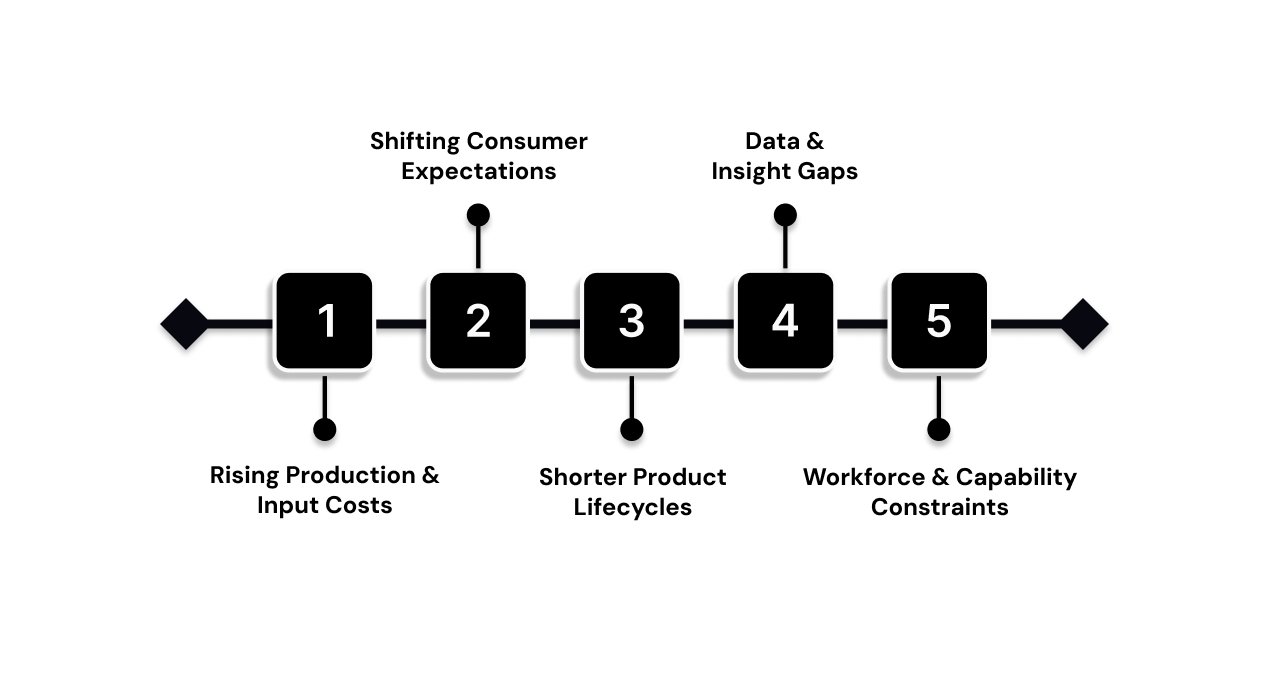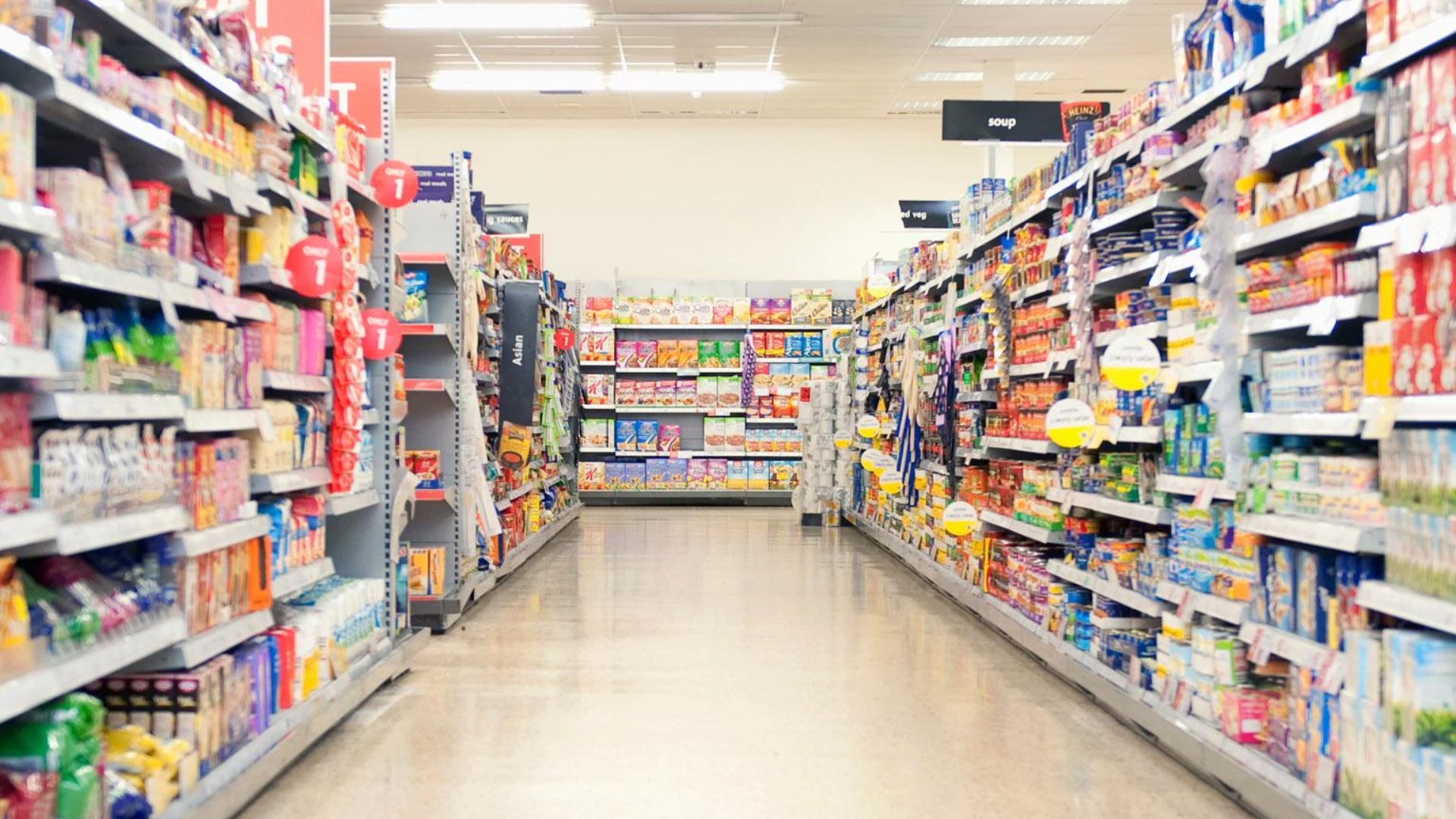In 2025, the consumer goods industry(CPG) challenges are becoming more complex, with the CPG sector projected to reach USD 2.1 trillion by 2032 at a CAGR of 4.1%, evolving at an accelerated pace. Rapid technological advancements, shifting consumer expectations, and global economic pressures are reshaping how brands operate in physical retail spaces.
Brands are facing constant challenges to maintain profitability while adapting to these changes. Currently, many CPGs use manual store checks, but these can’t scale to thousands of outlets, leading to blind spots and slow reactions.
While innovation continues at pace, brands that fail to maintain on-shelf availability or planogram compliance risk losing visibility and sales. In this environment, staying agile and adopting new approaches is no longer optional; it’s essential for CPG brands to maintain control and respond effectively to these challenges.
Key Takeaways:
- Rising Costs and Margins: Higher production and packaging costs make efficient shelf execution crucial to protect profitability.
- Changing Consumer Expectations: Consumers expect products to be visible, available, and correctly placed, driving the need for precise in-store management.
- Shorter Product Lifecycles: Frequent product launches need quick checks of placements, promotions, and planogram compliance to avoid mistakes.
- Data and Workforce Constraints: Limited real-time insights and field resources demand AI-driven audits and actionable analytics for consistent execution.
Key Challenges in the Consumer Goods Industry 2025

In 2025, CPG brands face several interrelated challenges that directly impact their in-store execution and product visibility. From rising costs to workforce constraints, each challenge requires a precise understanding of how products perform on the shelves and where gaps exist.
Below are the major challenges CPG brands are facing in 2025.
1. Rising Production and Input Costs
One of the most pressing challenges for CPG brands is the continuous rise in production and raw material costs. Packaging and ingredient expenses have increased due to inflation and regulatory pressures, directly affecting what happens on the shelves. These rising costs put significant pressure on profit margins, making efficient in-store execution more critical than ever.
Higher costs mean brands cannot afford to lose sales due to empty shelves or misplaced products. Even minor execution errors can lead to significant revenue losses over time. Ensuring every SKU is visible and in the correct position becomes a direct method of protecting margins.
Managing execution across thousands of stores is challenging without accurate data. Brands that rely on manual audits often miss key gaps. This often leads to stockouts, promotional failures, or planogram non-compliance, making rising costs even harder to manage.
Potential Solutions
- Real-Time Stock Visibility: Track on-shelf availability continuously to ensure products are always present and correctly displayed, reducing lost sales from stockouts.
- Planogram Compliance Monitoring: Monitor placement accuracy for all SKUs to maintain a consistent brand presence and avoid revenue loss due to execution errors.
- Rapid Issue Resolution: Quickly detect and address shelf execution gaps in stores to minimise the financial impact of errors caused by rising costs.
2. Shifting Consumer Expectations
Consumer expectations are evolving rapidly. Shoppers now demand product availability, proper placement, and consistent visibility at the point of purchase. If products aren’t where consumers expect them, brands risk losing loyalty and sales to competitors.
Brands must adapt to this shift by ensuring that high-demand SKUs are always visible and accessible on the shelf. On-shelf execution errors, such as misplaced items or incomplete displays, can make consumers lose trust and reduce the effectiveness of promotional campaigns.
Moreover, the pace at which consumer preferences change requires brands to react quickly. Brands must implement new products or promotional strategies in stores accurately to stay relevant and meet expectations.
Practical Solutions
- Shelf-Share Tracking: Continuously monitor the share of shelf for key SKUs to ensure they remain visible and accessible to consumers at all times.
- Promotion Execution: Verify that all promotional materials are correctly displayed to capture consumer attention and support campaign success.
- Audit Coverage Expansion: Digitized store audits allow brands to inspect more stores efficiently, ensuring consistency in product visibility and planogram compliance.
3. Shorter Product Lifecycles
Product lifecycles are shortening due to rapid innovation and frequent new launches. This poses a challenge for brands to manage shelf space effectively and ensure new SKUs are displayed correctly while older products are phased out.
Short lifecycles increase the risk of execution errors, such as new products being misplaced or old SKUs lingering on the shelf, which can confuse consumers and dilute brand presence. Without proper visibility, new launches may not achieve the impact brands expect.
Additionally, field teams often struggle to keep pace with constant product changes across multiple store locations. Traditional auditing methods are too slow to respond to these rapid shifts, creating gaps in execution and lost opportunities.
Simple Solutions
- Fast SKU Detection: Train AI models rapidly to recognize new SKUs on shelves, ensuring that new products are monitored from the moment they arrive in stores.
- Automated Shelf Monitoring: Use AI to continuously verify that both new and existing products are correctly placed according to the planogram.
- Execution Gap Alerts: Receive detailed alerts highlighting discrepancies in product placement, allowing field teams to take corrective action without delay.
4. Data and Insight Gaps
A lack of accurate, up-to-date in-store retail execution data remains a major challenge for CPG brands. Manual audits cover limited stores and often lead to errors, leaving brands with incomplete information about shelf visibility and product placement.
This gap prevents teams from understanding where stockouts occur, whether planograms are followed, or if promotions are executed correctly. Without timely insights, field teams respond slowly, leading to missed sales and marketing opportunities.
The challenge grows across large retail networks, where thousands of stores need monitoring. Brands require technology solutions that provide real-time shelf status clearly and help teams act quickly.
Actionable Solutions
- Digitized Store Audits: Use AI-based image recognition to perform faster, more accurate store audits, covering a larger number of locations than traditional methods.
- Real-Time Insights: Access up-to-date shelf data to identify stockouts, planogram deviations, and promotion issues, so that teams can act immediately.
- Actionable Recommendations: Provide field teams with clear, actionable guidance on correcting shelf issues, helping reduce errors and improving overall store compliance.
5. Workforce and Capability Constraints
Field teams are crucial for successful in-store retail execution, but workforce limitations create challenges. High turnover, uneven training, and skill gaps often lead to inconsistent audits and errors.
Even with well-designed strategies, brands may struggle to maintain compliance and visibility without a capable field workforce. Manual reporting is slow, and errors are hard to correct, particularly when teams cover large territories.
The pressure to execute flawlessly with limited resources makes automation and intelligent insights critical. Brands need solutions that support field teams in identifying and correcting issues quickly without relying heavily on manual work.
Viable Solutions
- AI-Assisted Execution: Equip field teams with actionable insights to reduce manual effort and make execution more efficient, regardless of skill level.
- Coverage Optimization: Enable teams to audit more stores per day without expanding headcount, ensuring broader compliance and better shelf visibility.
- Training Support: Reduce the need for extensive training by providing automated, data-driven guidance that directs teams on where and how to fix in-store execution gaps.
Emerging Trends Reshaping CPG in 2025

The way CPG brands manage stores is changing due to several trends that are influencing in-store execution:
1. Integration of Artificial Intelligence in Product Development
AI is being used to analyze consumer trends, predict preferences, and optimize product formulations. Brands need accurate shelf monitoring to understand how these AI-driven innovations perform in physical stores.
Visual shelf data provides valuable feedback on SKU placement and compliance, enabling brands to make informed decisions about product development. Early detection of deviations allows quick corrective actions for new launches. This creates a feedback loop connecting innovation with in-store execution performance.
2. Real-Time Competitive Benchmarking
CPG brands are increasingly monitoring competitor SKUs on the shelves to understand their placement, visibility, and share of shelf. Real-time insights help brands react quickly to gaps or oversaturation in specific locations.
Tracking competitor presence ensures that high-priority products maintain visibility, promotional compliance, and relevance in-store. This trend highlights why proactive shelf monitoring is essential for maintaining competitiveness in physical retail.
3. Adaptive Planogram Strategies
Planograms are no longer static; brands are adopting adaptive layouts that respond to seasonal trends, local preferences, and promotional campaigns. Brands monitor product placement in real time to ensure compliance in these dynamic layouts.
Brands track deviations from planned displays. This helps them maintain consistent visibility and optimal execution even when shelves change frequently. This trend highlights the need for flexible yet accurate shelf management strategies.
4. Efficient Field Team Resource Allocation
Field teams are essential for in-store execution, but limited resources make coverage a challenge. Brands use visual shelf data to prioritize stores needing immediate corrective action.
Field agents focus on stores where they can make the biggest impact. By allocating resources efficiently, brands maintain consistent shelf standards and reduce execution gaps across multiple stores.
5. Automation of Routine Tasks
Automation is streamlining repetitive in-store tasks, such as auditing and planogram verification. Brands reduce manual work, enabling field teams to focus on corrective actions rather than routine monitoring.
Automated solutions enhance accuracy, expand coverage to more stores, and deliver continuous, real-time insights. This ensures consistent execution standards without adding workforce pressure or complexity.
These trends highlight a shift from reactive strategies to proactive, data-driven retail execution. Brands that leverage these tools can reduce errors, enhance shelf performance, and maintain competitiveness in a crowded marketplace.
How ParallelDots Supports CPG Brands in 2025?
ParallelDots offers advanced solutions tailored to address the evolving challenges faced by CPG brands in 2025. By combining AI-powered image recognition with real-time reporting, ParallelDots helps brands make informed decisions about their in-store execution.
Here’s how we can help:
1. On-Shelf Stock Visibility: ParallelDots monitors every shelf in real time, providing detailed insights into which SKUs are available and which are missing. This enables teams to prioritize stores that require immediate attention and reduce lost sales due to stockouts, ensuring every product maintains its intended presence.
2. Share of Shelf Tracking: Paralleldots Shelfwatch retail execution software helps brands measure how much shelf space each product occupies relative to competitors. By understanding share of shelf, CPG companies can identify opportunities to increase visibility, reinforce brand prominence, and ensure top-selling SKUs are always in the right position.
3. Planogram Compliance Monitoring: ParallelDots detects deviations from pre-set shelf layouts, allowing field teams to correct misplacements quickly. This ensures that products are displayed according to brand guidelines, maximizing promotional effectiveness and supporting consistent consumer experiences across all stores.
4. Promotional Execution Verification: With automated tracking, brands can ensure that promotional campaigns are implemented accurately in every store. ParallelDots provides actionable data to highlight missing signage, misplaced promotional SKUs, or incorrect pricing, helping teams maintain ROI and reduce execution errors.
5. Data-Driven Store Audits: ParallelDots accelerates traditional store audits by digitizing the process with AI-powered image recognition. This enables field agents to cover more stores in less time, focusing their efforts on locations that need corrective action, and ensuring retail execution remains consistent and efficient.
With these solutions, ParallelDots helps brands maintain control over their physical store presence, monitor execution performance, and respond efficiently to the challenges. Request a demo today to see how ShelfWatch can optimize your retail execution and maximize on-shelf performance.
Frequently Asked Questions
1. How is digital transformation changing the way consumer goods companies operate?
Digital transformation is enabling consumer goods companies to operate more efficiently and responsively. By integrating AI and data analytics, companies can ensure products are correctly placed on shelves, improve in-store visibility, and enhance retail execution. These technologies support real-time decision-making at the store level, helping brands quickly respond to changing consumer needs.
2. What innovations in packaging are driving consumer engagement in 2025?
In 2025, smart and sustainable packaging is reshaping consumer engagement. QR codes and eco-friendly materials enhance brand storytelling, while biodegradable and reusable packaging aligns with sustainability values. These innovations draw attention to shelves, deepen consumer trust, and encourage environmentally conscious purchasing decisions.
3. What strategies are companies using to maintain brand loyalty in a competitive marketplace?
Companies maintain brand loyalty by ensuring their products are always visible, correctly placed, and engaging at the point of sale. Offering sustainable products, transparent packaging, and in-store promotions helps strengthen emotional connections. By focusing on retail execution and shelf-level engagement, brands can build trust and foster long-term relationships despite increasing competition.
4. How can consumer goods brands build resilience against future economic uncertainty?
Brands build resilience by focusing on consistent shelf execution, agile placement of new products, and in-store promotional strategies. Using digital tools for real-time store audits and actionable analytics helps maintain visibility and prevent missed sales opportunities. Additionally, emphasizing point-of-sale engagement and adaptable marketing approaches allows companies to navigate economic fluctuations while maintaining brand reputation and consumer trust.


